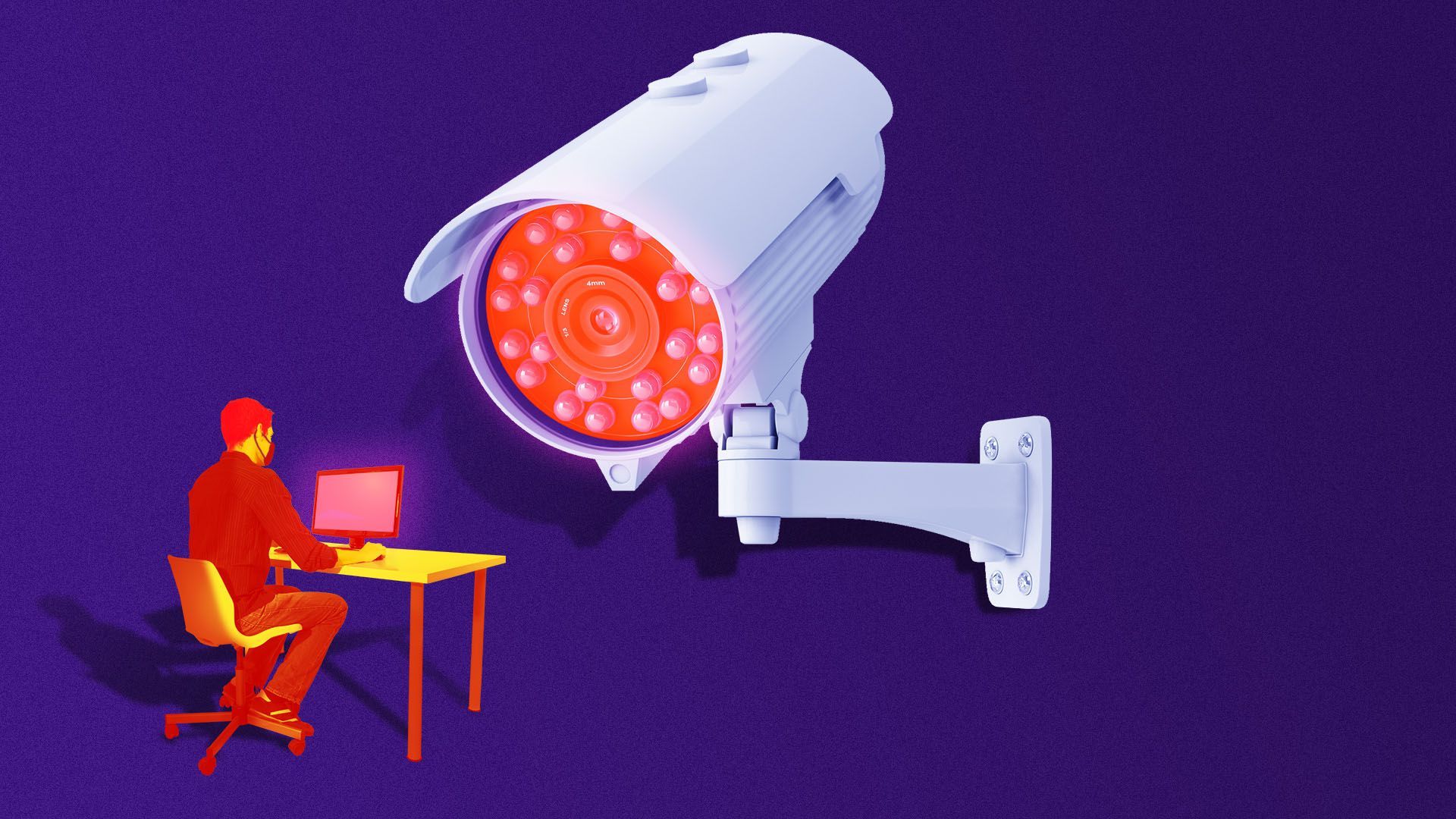| | | | | | | | | | | Axios @Work | | By Erica Pandey ·Dec 08, 2020 | | Welcome back to @Work. As always, send your thoughts to me at erica@axios.com or start a conversation on Twitter @erica_pandey. ⛅ Heads-up: @Work will be coming to your inboxes on Wednesday mornings instead of Tuesday afternoon starting next week. Looking forward to joining you for that post-breakfast second cup of coffee! I've got 1,576 words for you today, which should take 6 minutes to read. Let's start with... | | | | | | 1 big thing: American workers' stunning pivot |  | | | Illustration: Eniola Odetunde/Axios | | | | Even after the pandemic is behind us, millions of jobs — most of them in the travel and service industries — will be gone forever, and workers are figuring out their next moves. The big picture: Pivoting from one career to a whole new one is a difficult feat, but many have pulled it off. That could be a good sign for America's resilience amid the pandemic's economic destruction. - "The American worker has proven to be extremely adaptable," says Jane Oates, president of WorkingNation, a nonprofit that raises awareness about the challenges facing U.S. workers, and a former Labor Department official.
There are examples of pivoting from the worker level all the way up to the Fortune 500 level, she says. - Former bartenders and restaurant workers have joined training programs and found new jobs at tech companies, the New York Times reports.
- Restaurants are selling groceries as a new way to make money in the era of social distancing.
- GM pivoted from cars to ventilators when America needed to fill a shortage.
Case in point: I spoke with Deleyse Rowe, who worked on a cruise ship's service staff until her entire industry was walloped by the pandemic in March. - For a couple of weeks, Rowe was hopeful that things would quickly get back to normal. "Then I started to see everything shut down, and I thought, 'OK, this is not coming back for a while,'" she says.
- Rowe enrolled in a free Amazon Web Services training course at Per Scholas, a nonprofit that provides technology education to low-income adults. The course was funded by AWS, and after completing it, Rowe got a job working at one of the tech giant's data centers, where she's making more than she did on the cruise ship.
- Rowe loves her new job, but the quick switch wasn't easy. "I can't lie. It's been tough," she says. Rowe says she periodically reaches back out to her former Per Scholas teachers for tips.
But, but, but: Even though there are prominent success stories, preparing millions of displaced workers for the post-pandemic economy won't be possible without massive federal investment, experts say. - "We need a New Deal for skills," Amit Sevak, president of Revature, a company that hires workers, trains them to use digital tools and helps place them in jobs, told the New York Times.
The bottom line: "We're in a Cambrian explosion period of experimentation with new ways of working," says Roy Bahat, a future of work expert and head of Bloomberg Beta, a venture fund backed by Bloomberg LP. "It's showing people will try to adapt if they must." - "The issue is that it's unclear if it's actually working. Is it keeping businesses alive? Is it keeping workers employed? Or is it more like a stopgap than meaningful resilience that will produce lasting benefits?" says Bahat.
|     | | | | | | 2. The pandemic holiday party |  | | | Illustration: Eniola Odetunde/Axios | | | | A run-of-the-mill Zoom happy hour isn't going to fly with employees who are accustomed to fancy end-of-year corporate holiday parties. Here's how some companies are trying to make this year's pandemic-friendly, virtual holiday bash special. - Remote, a human resources startup that was launched this year, is distributing virtual reality headsets to all 60 employees so they can have an in-person holiday party experience.
- Akrete, a public relations company, has organized a 1.5-hour video party that will begin with a mixology class and end with CEO Margy Sweeney personally toasting and thanking each employee. Staff will be sent kits with ingredients to make two cocktails at home.
- PayPal is putting together a 29-hour virtual event that employees can pop in and out of as they please. The agenda includes cooking classes, a magic show, circus performers and a dance-off.
The bottom line: It's not easy to organize virtual parties and constantly think of new, creative, fun things to do. Take the time to thank the human resources folks at your company who are trying their darnedest to make the best of a crappy year. |     | | | | | | 3. Charted: Most employers didn't pay furloughed workers' health care premiums |  Data: Bureau of Labor Statistics; Chart: Andrew Witherspoon/Axios When the coronavirus forced businesses to tell their employees not to work, most kept paying at least some of those workers' wages — but not their health insurance premiums, writes Axios health care editor Sam Baker. Why it matters: Millions of people have lost their incomes and their health care coverage at the same time during this pandemic, which could stick them with unaffordable medical bills or cause them to put off the care they need. The big picture: Nationwide, 52% of businesses told employees not to work at some point this year because of the pandemic, according to data from the Bureau of Labor Statistics. - In the spring, for example, many restaurants and retail stores didn't fire or lay off their workers, but employees were simply unable to go to work because those businesses were closed or operating with only a skeletal staff.
By the numbers: Of the companies that told some employees not to work, most — 51% — kept paying at least some of those workers. - But only 42% of those businesses kept paying those workers' health insurance premiums, according to the BLS data.
- The industries hit hardest by the economic downturn — the ones where workers were most likely to have their hours cut or eliminated — were the least likely to keep paying health care costs.
Between the lines: The average employer-based health care plan in the U.S. costs about $7,000 per year for an individual and $20,000 for a family. Employers, not workers, pay the bulk of those premiums. - That's a big, fixed expense that simply may not be sustainable for many employers in this economy — even ones that could afford to keep some of their workers' wages flowing.
The bottom line: Tying insurance coverage to employment leaves people in a lurch whenever the economy turns south. |     | | | | | | A message from Axios | | AxiosHQ: Your tool for smarter internal comms | | |  | | | | Nearly 30% of projects fail from poor communication — but they don't have to. - AxiosHQ is a new writing tool that helps you communicate with staff more clearly and effectively.
Early users are seeing better alignment and soaring open rates. Learn more. | | | | | | 4. Watched at work |  | | | Illustration: Sarah Grillo/Axios | | | | Microsoft has a frightening new tool called "Productivity Score" that lets managers track how often workers are using Word and Excel, how many emails they're sending on Outlook, and how many video meetings they're attending on Teams or Skype. The big picture: In total, there are "73 pieces of granular data about worker behavior employers have access to, all associated with employees by name in a handy dashboard," writes Forbes' Rachel Sandler. Why it matters: Just as the coronavirus pandemic has acted as an accelerant for the adoption of remote work, it has also normalized increased surveillance and data collection such as the "Productivity Score." - Some employers are taking workers' temperatures and collecting medical histories in the name of safety.
- Others are using trackers to surveil their remote employees because they might doubt their ability to get work done at home.
The bottom line: Integrating such invasive surveillance technology into the workplace can swiftly erode workers' trust in their bosses and push them to quit. - "It's horrendous," J.S. Nelson, an associate professor of law at Villanova University, told Forbes' Sandler. "Why are they monitoring people this way and what is that telling people about the relationship they should have with their employers in the workplace? What message are you sending?"
Go deeper: The pandemic is ushering in a new era of workplace surveillance |     | | | | | | 5. Staggering stat: The rich get richer |  | | | Illustration: Sarah Grillo/Axios | | | | Annual wages of the top 0.1% of U.S. earners increased a whopping 345% in recent decades, from $649,725 in 1979 to nearly $2.9 million in 2019, according to a new report from the Economic Policy Institute. - For the bottom 90%, wage growth during the same 40-year period was a measly 26%, from $30,880 to $38,923.
What to watch: The pandemic has exacerbated inequalities in every facet of American life. Look for these wage disparities to get even worse in its aftermath. |     | | | | | | 6. Worthy of your time |  | | | Illustration: Aïda Amer/Axios | | | | Amazon's great land-grab (Axios) - Amazon has increased its workforce by well over 400,000 people this year alone, bringing total headcount to more than 1.2 million. No company has never expanded this fast — and the fact that Amazon is adding so aggressively to its full-time workforce shows that the retailer sees this growth as permanent, rather than being a temporary artifact of the pandemic.
How to take breaks when working from home (Fast Company) - It can be hard to figure out when to stop working when the home and the office are completely blended together. One effective strategy is to schedule breaks on your calendar.
The viral comfort of nostalgia (Wired) - If you're re-binging old favorite shows over and over again, you're not alone. We're all looking for cozy, familiar things to get us through the coronavirus winter, and research shows that nostalgia can fight feelings of loneliness and anxiety.
Finding joy in your old cubicle (Wall Street Journal) - The Journal's Te-Ping Chen spoke to office workers around the country who have (safely) returned to their workplaces. Two big takeaways: 1) Social distancing means you have to do video call meetings with your colleagues even if they're at the office with you, and 2) don't underestimate how much your dog will miss you.
|     | | | | | | 7. 1 fun thing: Pandemic workplace slang | | Our nine-month-long remote work stint has generated new office slang around the world, the Economist reports: - Toxic productivity: "Hours saved traveling have been filled with high-speed email traffic. The distinction between workplace and home has blurred, and bosses now call on subordinates at all hours of the day. Every waking moment is a slot to achieve things in. The term for this inability to switch off is 'toxic productivity.'"
- Zumping: A portmanteau of Zoom and dumping, "zumping" is firing employees by video. "Some companies have chosen to scale up the method, however, by firing many people — sometimes thousands — in a single Zoom session. Tech firms seem particularly prone. In May, a tearful Uber executive laid off 3,500 people on one call, her eyes appearing to dart away off-camera (perhaps towards a script, some observers suggested)."
And here's a bonus slang term that LinkedIn has coined for its annual "Big Ideas" list, out tomorrow: - 3-2-2: This will be the new 9-to-5 in the post-pandemic world as people cling to their remote work habits, spending three days in the office, two days at home and two days off.
Check out more slang terms in Japanese, Russian, Mandarin and more. |     | | | | | | A message from Axios | | AxiosHQ: Your tool for smarter internal comms | | |  | | | | Nearly 30% of projects fail from poor communication — but they don't have to. - AxiosHQ is a new writing tool that helps you communicate with staff more clearly and effectively.
Early users are seeing better alignment and soaring open rates. Learn more. | | | | Thanks for reading! | | | | Axios thanks our partners for supporting our newsletters.
Sponsorship has no influence on editorial content. Axios, 3100 Clarendon Blvd, Suite 1300, Arlington VA 22201 | | | You received this email because you signed up for newsletters from Axios.
Change your preferences or unsubscribe here. | | | Was this email forwarded to you?
Sign up now to get Axios in your inbox. | | | | Follow Axios on social media:    | | | | | |









No comments:
Post a Comment